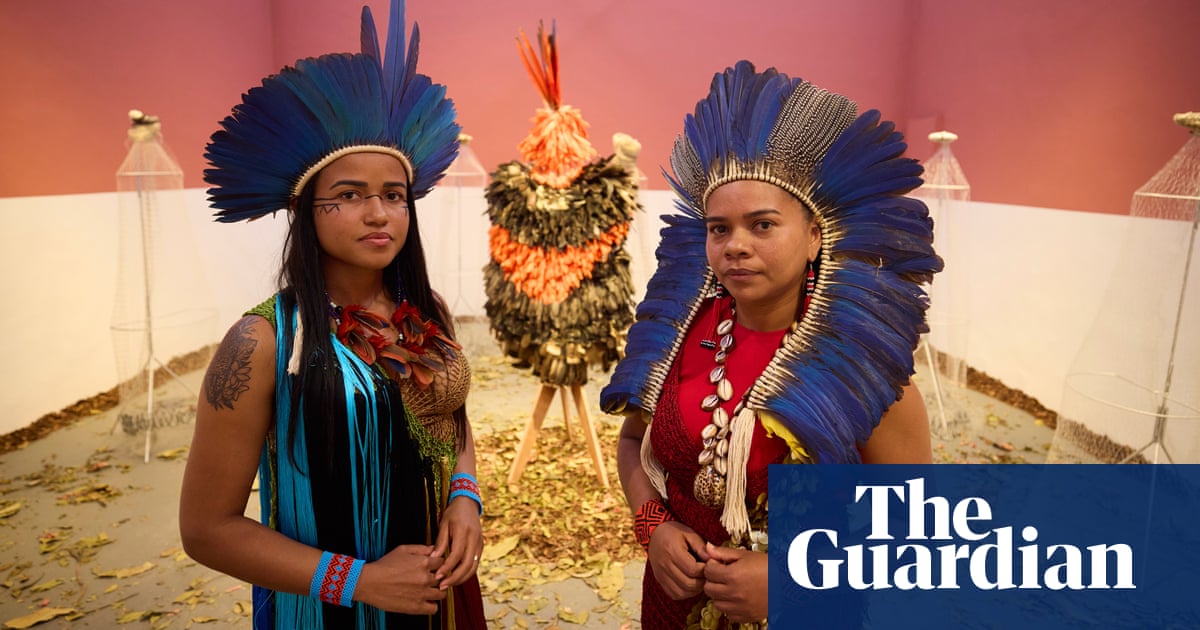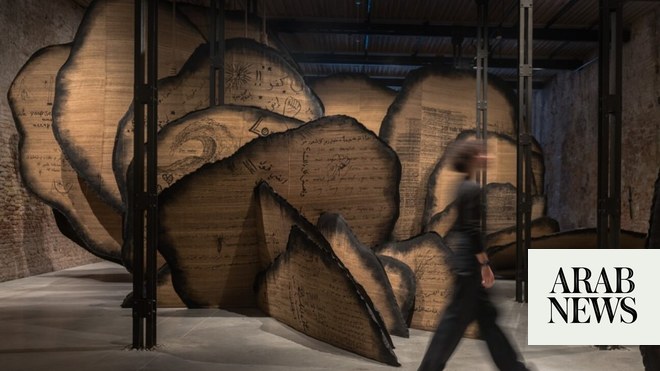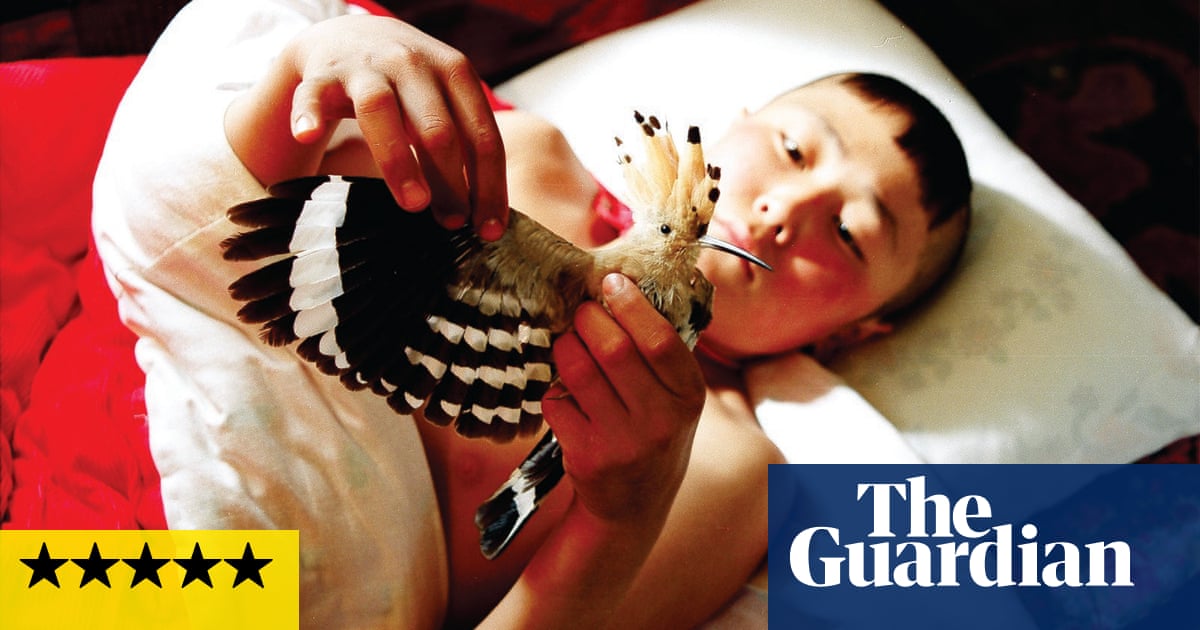
‘I’m not using the word ‘representing’ as I can’t represent Australia,” says the softly spoken Indigenous artist Archie Moore, recovering after the packed opening of the Australia pavilion at the Venice Biennale. “I can’t even represent all the Aboriginal people – because we’re not a homogenous group. So I choose to just say I’m presenting an exhibition for the Australia pavilion.”
Although First Nations artists have been to Venice before, with the Nordic pavilion hosting Sámi artists in 2022, this time they seem to have broken through en masse at the biennale. The main exhibition, called Foreigners Everywhere, is packed with their work, sourced from all over the world by the Brazilian curator Adriano Pedrosa. The idea is that being colonised makes you feel like a foreigner in your own country, with the erasure of your culture, the robbery of your land, and at worst the extermination of your people.
There are postcard-sized scenes of life as an Indigenous woman in Guatemala by the late Rosa Elena Curruchich; an image of a wise man emerging from a sacred pond by the Amazonian artist Aycoobo; and the timeless geometric wooden carvings of Māori artist Fred Graham. More Māoris, the Mataaho Collective, won a prize for their shimmering canopy made out of the heavy-duty straps used to secure loads to trucks, which hovers over viewers’ heads as they head into the Arsenale. Almost every wall text for pieces by Indigenous artists notes that this is their first time at the biennale.
Their presence has made an impact. On Saturday, Moore’s show, called kith and kin, won the top prize, the Golden Lion, a first for an Australian artist. Moore painted the interior of the pavilion black and then drew a speculative family tree on the walls going back 65,000 years. This was in white chalk as a nod to his schooldays, when he learned virtually nothing about his heritage (he laughs when I ask if he had any Indigenous teachers). The dating refers to when the first Australians are believed to have existed – they are thought to be one of the oldest peoples on earth.
As you look up into the family tree, it becomes illegible and fades into the darkness of the ceiling. “I’m trying to include everyone in the tree, because if you go back 3,000 years we all have a common ancestor,” Moore says. “I’m saying we’re all connected and we’re all human beings living on Earth and we should have respect for each other and show kindness.”
There’s a distinct absence of respect and kindness in the enormous white platform that sits in the middle of the pavilion, ringed by a ceremonial mourning pool. On this platform, Moore has piled coroner reports into 557 Aboriginal deaths in custody since 1991 – “sourced from a Guardian database,” he adds. The work speaks to the wildly disproportionate incarceration rates that blight the lives of Indigenous Australians. “We are 3.8% of the population, but 33% of the prison population,” Moore says. “And Aboriginal people will go to jail more easily just for trivial offences like littering or drinking in public.”
Now we are in the main role – the protagonists and authors of our own history
Ziel Karapotó
Last October, Australia had a national referendum about whether it would recognise Indigenous people in the constitution via a parliamentary advisory body of First Nations people known as the voice. It was ignominiously defeated after the rightwing Liberal party refused to support it. The referendum “didn’t influence the work”, which was already under way, Moore says, adding that the result was “no surprise”. Yet in its own time-spanning, quietly eloquent way, kith and kin seems to embody the kind of voices Australia declined to listen to, but people overseas might. “I’m not sure how much people over here know about Aboriginal art or Aboriginal people or the history,” Moore says. “So this is maybe one thing I can tell them about.”
Round the corner from the Australia pavilion, there is a bright red painted pedestal outside the American pavilion. The rooms inside are filled with beaded sculptures of birds, priestlike figures with ceramic heads and multicoloured fringes, as well as a video of a Native American woman called Sarah Ortegon HighWalking performing a jingle dance to thumping techno. At the entrance, you can pick up a psychedelic badge with the slogan: “Every body is sacred.” Taken as a whole, it’s part rave, part powwow, part drag show, part protest march, featuring singing, drumming, regalia and ceremonies that were all previously outlawed in North America in an attempt to suppress Native culture.
Called the space in which to place me, the work is by Jeffrey Gibson, a Mississippi Choctaw/Cherokee artist. On the Wednesday morning of the opening week, he is relaxing with his Norwegian husband and their two children. Wearing a lifesize pendant of a slug around his neck, Gibson is reminiscing about his time as an art student in London during the late 1990s, when he was a regular at gay club the Fridge and at cutting-edge jungle night Metalheadz.
Gibson says the starting point for his pavilion was the fact that “the term ‘nation’ means something very different to many Indigenous people when we speak about national pavilions and nationhood”. He also wanted to show all the aspects of his work, from performance to ephemera. “Terms like kitsch and queer and novelty and craft are central in my practice,” he says. “I’m telling my story – being queer, being American, being a parent – but also making space for you to find parallels. That is the most important thing.”
The biennale lasts until November, by which point Donald Trump may have been voted back in for a second assault on democracy. Will Gibson’s flag-festooned, psychedelic pavilion then seem more like a wake than a celebration? “It is frightening,” Gibson says. “But I do feel that the majority of voices want there to be peace and democracy in the US. This is a call for us to gather and to speak loudly.”
Down the hill there’s the Denmark pavilion, although “Denmark” has been crossed out and replaced with the words “Kalaallit Nunaat” (“the land of the Kalaallit”). This is a display by the artist Inuuteq Storch, who is from Greenland, a country of just 57,000 that was colonised by the Danes in 1921. Storch says that there would be around 250,000 to 300,000 Greenlanders now, but the birth rate was suppressed, with scores of women fitted with contraceptive coils without their knowledge. More than 100 are now suing the Danish government. “We can get university-level education in Denmark,” Storch says. “Yet there are these stories. So there’s always this love/hate relationship.”
The 31-year-old photographer, whose disposition, he acknowledges, is “very chill”, is reclining on one of three hammocks outside the pavilion. Lying in them, you can enjoy a wraparound image of the view from his balcony at home printed on the walls – Storch says that the sight of the freezing seascape and the spectacular sky above it gives him energy.
His exhibition, called Rise of the Sunken Sun, takes in six photographic series, including Necromancer – eerie images printed on transparent plastic that nod to the region’s suppressed but ingrained shamanic spirituality. Storch shows me the tattoos on his forearms. On his left there is an image of Torngarsuk, a smiling bear wearing a harness. This is the “helping spirit” revered by the Kalaallit people, but which the Danes consider an equivalent to Satan and whose name is a swear word. On his right arm there is Arnarulunnguaq, an Inuit woman in a fur bonnet. “She is the reason the fifth Polar Expedition was successful,” Storch says, referring to the conquest in the early 1920s. “But the whole credit went to Knud Rasmussen. She was making the food, she was doing all the clothes. She’s actually the real hero.”
As we talk, pro-Palestinian protesters come through the Gardineri to form a flashmob outside the Israeli pavilion – which the artist Ruth Patir decided to close until a ceasefire is reached in Gaza. “The riots are here again,” Storch remarks. “They’re very important. Personally, I’m very supporting of the riots against the war, but I’m very far from the war. I’d rather concentrate on what we can fight for in my country.”
These struggles are shown in the photographs Storch took in Qaanaaq, one of the world’s most northern towns. “Its people are living around a lot of animals, but the hunting is limited by the Danes,” Storch says. “People can get fresh avocados, but they’re not allowed to hunt natural food.” In 1953, 27 Kalaallit families were forced off their ancestral hunting grounds to make way for a US airbase; now, their enemy is more likely to be the climate emergency. Storch’s photographs highlight the humans on the frontline of these existential struggles, often through humour – as in his shot of a hand throwing the devil’s horns sign in front of a melting ice cliff. The artist hunts himself, too, and with a grin, uses my phone to tell me the last bird he killed and ate. It was a “very tasty” rock ptarmigan.
The Dutch pavilion has been taken over by a Congolese workers’ collective called CATPC, whose installation is a shocking cri de coeur about the catastrophic cost of the forced extraction of cacao and palm oil from their land. Palm oil oozes from the ceiling; the gallery is filled with sculptures made of clay, cacao and palm oil depicting rape and pillage; a performance film puts museums and galleries on trial for their “ideologies of dominance”. Over in the Brazilian pavilion, which has been renamed Hãhãwpuá and contains work by a trio of Indigenous artists, museums are indicted there too, with letters displayed asking for the return of a sacred feathery mantle called the Tupinambá cloak – which needless to say went unanswered.
With its bloodstained floors and flying poison arrows, the Hãhãwpuá pavilion is as disturbing as it is beautiful. But the presence of so many Indigenous artists in Venice, and the high quality of their work, has its own potency.
“Now we are in the main role, the protagonists and authors of our own history,” says Ziel Karapotó, one of the artists, who is wearing a bright orange coat and a traditional blue feathered headdress. “That’s a new thing in Brazil – and especially in the art world. The planet is sick and a cure depends on all of us. But I believe that the non-Indigenous need to listen to us. Because our way of life could be a solution.”












